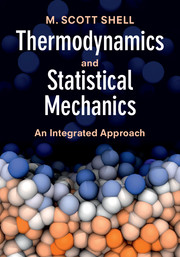Book contents
- Frontmatter
- Contents
- Preface
- Reference tables
- 1 Introduction and guide for this text
- 2 Equilibrium and entropy
- 3 Energy and how the microscopic world works
- 4 Entropy and how the macroscopic world works
- 5 The fundamental equation
- 6 The first law and reversibility
- 7 Legendre transforms and other potentials
- 8 Maxwell relations and measurable properties
- 9 Gases
- 10 Phase equilibrium
- 11 Stability
- 12 Solutions: fundamentals
- 13 Solutions: advanced and special cases
- 14 Solids
- 15 The third law
- 16 The canonical partition function
- 17 Fluctuations
- 18 Statistical mechanics of classical systems
- 19 Other ensembles
- 20 Reaction equilibrium
- 21 Reaction coordinates and rates
- 22 Molecular simulation methods
- Index
- References
7 - Legendre transforms and other potentials
Published online by Cambridge University Press: 05 April 2015
- Frontmatter
- Contents
- Preface
- Reference tables
- 1 Introduction and guide for this text
- 2 Equilibrium and entropy
- 3 Energy and how the microscopic world works
- 4 Entropy and how the macroscopic world works
- 5 The fundamental equation
- 6 The first law and reversibility
- 7 Legendre transforms and other potentials
- 8 Maxwell relations and measurable properties
- 9 Gases
- 10 Phase equilibrium
- 11 Stability
- 12 Solutions: fundamentals
- 13 Solutions: advanced and special cases
- 14 Solids
- 15 The third law
- 16 The canonical partition function
- 17 Fluctuations
- 18 Statistical mechanics of classical systems
- 19 Other ensembles
- 20 Reaction equilibrium
- 21 Reaction coordinates and rates
- 22 Molecular simulation methods
- Index
- References
Summary
New thermodynamic potentials from baths
We began our discussion of equilibrium by considering how the entropy emerges in isolated systems, finding that it is maximized under constant E, V, N conditions. In practical settings, however, systems are not often isolated and it is difficult to control their energy and volume in the presence of outside forces. Instead, it is easier to control so-called field parameters like temperature and pressure.
In this chapter, we will discuss the proper procedure for switching the independent variables of the fundamental equation for other thermodynamic quantities. In doing so, we will consider non-isolated systems that are held at constant temperature, pressure, and/or chemical potential through coupling to various kinds of baths. In such cases, we find that entropy maximization requires us to consider the entropy of both the system and its surroundings. Moreover, new thermodynamic quantities will naturally emerge in this analysis: additional so-called thermodynamic potentials.
To achieve conditions of constant temperature, pressure, or chemical potential, one couples a system to a bath. As discussed before, a bath is a large reservoir that can exchange energy, volume, or particles with the system of interest. While exchanging volume/energy/particles alters the system state, such changes are so minuscule for the bath that it is essentially always at the same equilibrium condition.
- Type
- Chapter
- Information
- Thermodynamics and Statistical MechanicsAn Integrated Approach, pp. 123 - 148Publisher: Cambridge University PressPrint publication year: 2015

